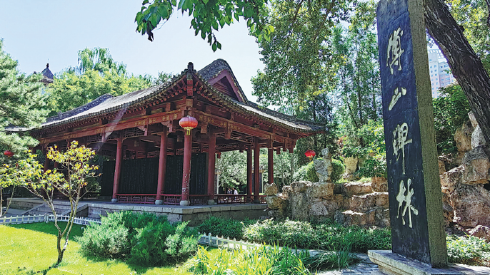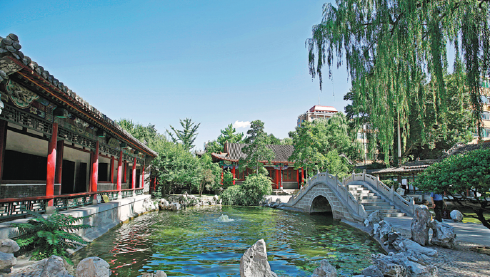
Home to 418 stone tablets inscribed with Fu's calligraphy, Beilin park is also called Fu Shan's Stone Tablets. [Photo by Li Yongjiang for China Daily]
Renowned calligrapher Fu Shan's classic works inscribed on stone tablets in hidden gem of Taiyuan
Established in 1990 and covering an area of 13,728 square meters, Beilin Park in Taiyuan, is far from prominent among many parks in the provincial capital of Shanxi province.
However, in the eyes of those passionate about ancient culture and calligraphy, the park, which literally means "stone tablets park", has special significance.
The park, featuring a great many inscriptions written by ancient and modern calligraphers, has received more than 100,000 visits annually over the past three decades.
The most reputed of all the calligraphers featured in the park is Fu Shan.
According to the park's officials, there are 418 stone tablets inscribed with Fu's calligraphy.
Fu Shan, also known as Fu Qingzhu, is a household name among Chinese readers who are fond of kung fu novels.
In one of the novels written by Hong Kong novelist Liang Yusheng, Fu was described as a master of martial arts and medical science.
Fu, who lived during the late Ming (1368-1644) and early Qing (1644-1911) dynasties, was actually one of the top scholars of his times.
In addition to Confucian studies, Fu was also known throughout the country for his achievements in arts and medicine.
His medical works, including Fu Qingzhu's Studies in Gynaecology, are still must-read books among today's doctors of traditional Chinese medicine.

Located in the center of Taiyuan, Beilin Park is a favored destination for locals to relax. [Photo by Li Yongjiang for China Daily]
But in Taiyuan, the birthplace of Fu, he is mostly remembered by the locals as a calligrapher.
"As the park is home to 418 stone tablets with Fu's calligraphy inscriptions, it is also called 'Fu Shan's Stone Tablets'," said Niu Shixin, the park's official in charge of tourism.
Niu explained that the park is divided into the northern and southern gardens, with the northern garden exclusively dedicated to Fu.
The official, who is an enthusiast of calligraphy himself, said the most precious stone tablet is the one called Wufengshan Cursive Script.
"Most of Fu's works were written on paper sheets and most of the stone tablets with his writings were copied from his paper works," Niu said, adding that the Wufengshan tablet has the original inscription directly written by Fu.
"The calligraphy work is an accurate demonstration of Fu's style, personality and even emotion," Niu said.
Niu's opinion was echoed by Cao Chong, a native of Shandong province who has been living in Taiyuan for more than 10 years.
"The cursive stroke of the writings resemble the shape of a running dragon, which gives viewers a visual impact. They are a demonstration of an overwhelming vitality typical of the writer," Cao said.
He said he can also identify the wilful, enterprising and even rebellious personality of Fu, judging from the unique expression of an extremely cursive style.
Local researchers said the artistic characteristics of Fu's works were also a reflection of his reaction to the dramatic changes of the times.
Fu lived the first half of his life during the decaying Ming Dynasty and then witnessed the brutal repression, slaughter and plundering by the invading Qing Dynasty forces in the process of conquering the country, according to Bai Qianshen, a researcher in Fu Shan.
"The new regime that replaced Ming was a disaster to the intellectuals, who were strictly prohibited from any free expression of their thoughts," Bai said, adding that a crackdown on free expression had led to a loss of vitality in academic and artistic circles.
To escape the turmoil of the times and show his discontent over the new regime, Fu fled to Wufengshan in the eastern suburbs of Taiyuan to live a secluded life as a Taoist monk.
He lived there for five years, and the Wufengshan Cursive Script was written during that period.
"The script was among the most renowned cursive-style works during his times, showing a great soul yearning for unconstrained freedom," Bai said.
According to the researcher, Fu was a master in all the five Chinese calligraphic styles: seal character, official script, regular script, running hand and cursive style.
Beilin Park shows the variety of styles in Fu's works.
The southern garden of the park has a display of stone tablets with calligraphy works written by dozens of other artists since the Ming Dynasty.
Guo Yanjie contributed to this story.
